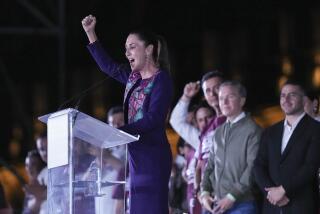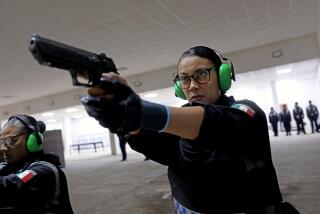Nicaragua’s curse
- Share via
MORE THAN half a century ago, a Nicaraguan historian wrote a book about his homeland called “Maldito Pais” -- the cursed country. Now, as shocked Nicaraguans mourn the sudden death of their country’s most promising politician, that title once again seems depressingly apt.
Several times in its history, Nicaragua has seemed poised for greatness. Each time, it has been dealt a blow that pushed it off the path. As a result, this unfortunate country, which has the resources to become a peaceful and prosperous democracy, is just the opposite.
This month, the most appealing presidential candidate Nicaragua has produced in modern times, Herty Lewites, died of a heart attack. Many Nicaraguans fear that, with his death, their hopes for national development have been crushed. Their parents, grandparents and great-grandparents would recognize their frustration.
The most formidable leader Nicaragua ever produced was Jose Santos Zelaya, who ruled in the first decade of the 20th century. He was a crusading reformer who built roads and ports, challenged the power of the clerical-backed elite and dreamed of converting his country from a feudal backwater into a modern capitalist state.
Zelaya’s nationalism, however, placed him in conflict with several American companies that were active in Nicaragua. They brought their complaints to Washington, and in 1909 the U.S. government engineered Zelaya’s overthrow. In his place it installed the chief accountant of an American mining company. With the help of U.S. Marines, he suppressed a series of rebellions and kept Nicaragua in its backward state.
Nicaragua had its next great chance in 1934, after the Marines finally withdrew. People cheered as its most famous rebel leader, Augusto Cesar Sandino, agreed to lay down his arms in order to help build a modern nation.
That did not please the commander of the newly formed National Guard, Anastasio Somoza Garcia, who correctly saw Sandino as an obstacle to his own ambitions. He had Sandino assassinated. With him died the hopes of yet another generation of Nicaraguans.
Somoza dominated Nicaragua until 1956, when he was himself murdered. His elder son, Luis, succeeded him. For a time, it seemed that Luis Somoza Debayle might break with his father’s example of tyranny and allow Nicaragua to become a democracy. But he died of a heart attack in 1967, and his rapaciously corrupt brother, Anastasio, seized the presidency. That plunged Nicaragua into another period of brutal repression.
The Somoza dynasty was finally overthrown in 1979 and replaced by a group of young idealists who called themselves the Sandinista National Liberation Front. Their electrifying military victory won them the jubilant support of nearly every Nicaraguan.
Through a combination of immaturity, arrogance and incompetence, however, Sandinista leaders -- including Daniel Ortega, who served as president from 1985 to 1990 and who is again running for president this year -- squandered their historic chance and turned most Nicaraguans against them. Their decade in power was a period of war, repression and steady impoverishment.
In the 16 years since the Sandinistas were voted out of power, Nicaragua’s misery has only grown. The country now competes with Haiti to lead the Western Hemisphere in everything bad, including rates of poverty, malnutrition and infant mortality. No leader emerged who seemed even remotely capable of setting the country right -- until Lewites.
Lewites had been a Sandinista guerrilla, a Cabinet minister in the Sandinista government and, from 2000 to 2005, the hugely popular mayor of Managua. In that post, he broke with Nicaraguan tradition by hiring people according to merit rather than party affiliation or personal loyalty.
He also became increasingly critical of the Sandinista leadership and directly challenged Ortega’s grip on the party. For his temerity, he was expelled from the Sandinista Front. He responded by founding his own party, the Movement for Sandinista Renewal, and declared his candidacy for president in the election scheduled for Nov. 5.
Lewites promised to end the system of strongman rule that has plagued Nicaragua. That, combined with his folksy, upbeat style, made him the most popular politician of his generation.
Many Nicaraguans saw in Lewites a chance, finally, to set their country on the road to stability and progress. They were stunned, and then plunged into a depression bordering on hopelessness, when he died July 1 at the age of 66.
U.S. officials had disdained Lewites as an unreconstructed leftist, but recently they appeared to be reconsidering. Just four days before his death, Deputy Secretary of State Thomas Shannon met with him in Managua.
During my last conversation with Lewites six months ago, he talked passionately about his dream of a new, modern Nicaragua. With what now seems to be eerie foresight, he also referred to his uncertain health. “I don’t need to be doing this,” he told me. “I’m not young, and I’ve already had a major heart attack. If I were thinking about myself instead of my country, I’d be spending the rest of my life in quiet retirement. That’s what my doctors have ordered. But I have other ideas.”
Nicaraguans now fear that those ideas may have died with Lewites, perhaps for another generation. Their despair suggests that Nicaragua, for all its promise, remains a country under the curse of fate.
More to Read
Sign up for Essential California
The most important California stories and recommendations in your inbox every morning.
You may occasionally receive promotional content from the Los Angeles Times.










